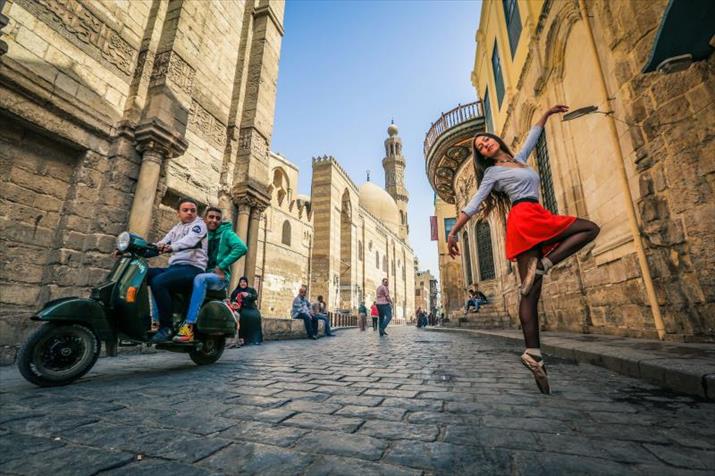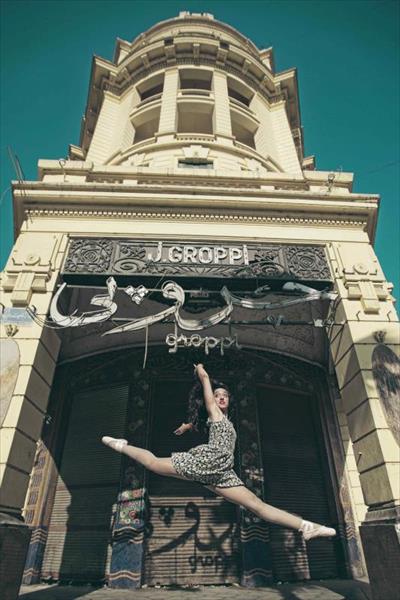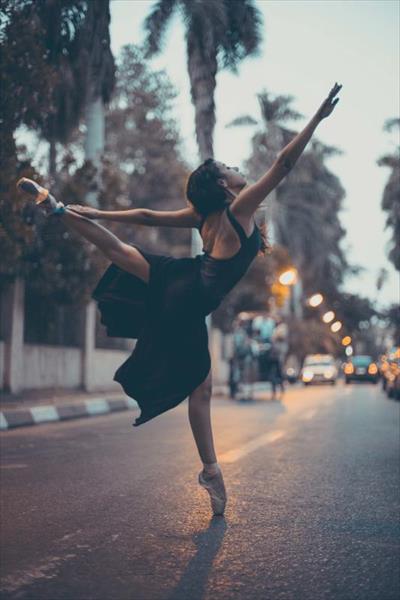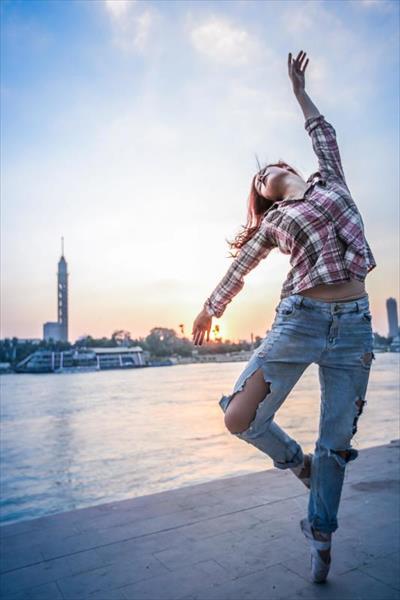|
||||||||||
| Home Nation World Business Opinion Lifestyle ChinAfrica Multimedia Columnists Documents Special Reports |
|
||||||||||
| Home Nation World Business Opinion Lifestyle ChinAfrica Multimedia Columnists Documents Special Reports |
| Africa |
| Corps de Cairo |
| Ballerinas dancing in the streets of Egypt while being captured by photographers are creating a new art movement in the country |
| By Sudeshna Sarkar | VOL. 8 February 2017 ·2017-02-07 |

As two women sit talking on the step of an old building in Cairo, a young woman comes and sits between them casually. Dressed in a white blouse and a short red skirt, she couldn't be any more different than the other two, both of whom are dressed in chador, the traditional garment worn by Muslim women consisting of a long cloth that envelops the body and head.
What she does next is an even greater contrast. She tightens the straps of her white silk shoes, which, on closer inspection, turn out to be the pointe shoes worn by ballerinas. Then she springs up with a lissome grace and leaving everyone around her spellbound, begins to dance in the old alley.
Since September 2015, this has been happening again and again in Cairo. The dancers are different and the locations vary but the purpose remains the same - telling the world about the Ballerinas of Cairo project.
Shall we dance?
It's been a hectic start to the New Year for Mohamed Taher. The 32-year-old Egyptian filmmaker has shot several videos and given several interviews, including one on Al Houm Show, the prime time news magazine aired by the United States-based Arabic language satellite TV channel Alhurra, with Mireille Azer, who was the first runner-up in the Miss Egypt 2016 beauty pageant and winner of Miss Egypt Grand 2016.
But Taher has a reputation for responding to all comments on the Ballerinas of Cairo's Facebook page within an hour. And he lives up to his formidable reputation, making time at near midnight to talk about his brainchild.

"I personally love ballet and one of my favorite films is Black Swan," he said, explaining what made him choose ballerinas as the subject of his photographic project. "Besides, I was really inspired by the Ballerina Project."
The Ballerina Project, started about 17 years ago by New York-based photographer Dane Shitagi, combines ballet and photography to produce what he calls "the etching of a ballerina's heart and emotions." The growing collection of photographs, displayed on social media, from Facebook to Instagram and Twitter, has fed the viewership and kept the project alive.
Taher's own plan was to get Egypt's ballerinas dancing on Cairo's old streets, creating a contrast between the graceful dancing and the "roughness" of the streets, photograph them, make videos and use social media, like Shitagi, to create buzz. At first, he was joined by fellow filmmaker Ahmed Fathy and on a morning of September 2015, the first shooting was held in El Korba, a historical area in Cairo founded in 1905 by a Belgian baron.
The first ballerina, Mariam El Gebali, came from the Cairo Opera House, a landmark in Egypt's cultural history. Built in the 19th century to celebrate the inauguration of the Suez Canal, it was an early example of Egypt's globalization. Designed by Italian architects, the opera house was the first of its kind in Africa, and one of the first operas to be performed there was Aida, specially written for the theater by Italian maestro Giuseppe Verdi.
Many of the dancers in Taher's Ballerinas of Cairo project are from the same opera house. "It's all due to networking," Taher said. "After we shot the first two sessions, many ballerinas approached us and also asked their friends to join the project."

Though a section of the media has portrayed the photographers and the ballerinas as being in danger from conservative Islamic clerics, Taher dismissed them, saying the reaction has been positive. "People get dazzled by what they see and they like it," he said. "It's something new on the streets of the capital. Most people appreciate the ballerinas and take photographs with them."
Marina Bahy, a 20-year-old mass communications student who also works as a ballet instructor in Cairo, is one of the participants in the project. "I started dancing in a sports club when I was six," she said. "When I was 12, I started dancing at the Cairo Opera House. A friend of mine told me about the project and I was very impressed with the idea and agreed immediately."
Her first shoot was on the iconic Sixth October Bridge on the Nile that is also known as the "spinal cord of Cairo." "I was a little nervous at the beginning but when I saw people's reactions, how they were impressed and happy, that comforted me and made me more excited about the project," Bahy said. Her parents were worried at the beginning. "But when they saw the pictures, they became as excited as I was."
Bahy says that she has benefited personally from the project: "It motivated me a lot as a ballerina. I was excited to practice more to be able to shoot more difficult moves." She hopes to continue with the project until it becomes "one of the best known ballet projects worldwide."
New window to Egypt
Veronica Emad, who is studying to be a tourist guide at the Ain Shams University in Cairo, started learning dancing at the Cairo Opera House when she was 11. "I liked the [Ballerinas of Cairo] idea at the beginning just for fun but after we did many shoots in different places, it has become one of my priorities," she said. "We became one family."
She remembers her first shoot with clarity. "There were many people in the street. A man was walking with his Dalmatian dog and we asked him if we could take a picture with the dog. He was very nice and said, 'With pleasure.'"
Emad thinks Ballerinas of Cairo has the potential to boost tourism in Egypt: "I hope to first travel [with Ballerinas of Cairo] to all cities in Egypt to promote tourism in Egypt, then show people around the world that we have many different types of tourism, from beautiful cities to Pharaonic monuments."

When he started the project, Taher's plan was to ultimately hold exhibitions in art galleries. But in less than two years, he has found the project growing many layers. "One of them is showing Egypt is safe," he said, a tacit reference to the earlier instability and terror attacks. Another is "women gaining their public spaces again," showing the streets are safe for women.
Yet another development has been the revival of ballet and photography. "Very few people know that Egypt has ballet too," he said. "We want to change that perception."
What began as his and Fathy's project has snowballed into a much larger initiative. Like the ballerinas, other photographers are also seeking to be involved in the project, their photographs adding to its repertoire.
Snowball effect
"I am one of the photographers who are determined to be filming in more places just to confirm that we are not different - we do not kill creativity, art and imagination - and to assure that Egypt is one of the most secure countries in the world," Omar Hefny, an 18-year-old physiotherapy student, said. "Ballerinas of Cairo is a very successful project due to the reaction of people in the streets during the filming and of course, the viewership on social media and our belief in this project."
Hefny bought his first camera four months ago, taught himself to use it from YouTube and since then, has been filming ballerinas and musicians playing on the streets of Cairo. And there are many more like him.
The project has also begun to catch the media's eye, from local publications and TV to the BBC and even the Italian edition of Vanity Fair. And people from across the world are appreciating the work.
On the Facebook page of Ballerinas of Cairo, Salvador Dominguez Sanchez, a U.S. resident, has posted the photograph of his daughter dancing in the street in New York City. His message is simple. "If you ever come to the United States, come to Cincinnati please!"
| About Us | Contact Us | Advertise with Us | Subscribe |
| Copyright Beijing Review All rights reserved 京ICP备08005356号-5 京公网安备110102005860号 |